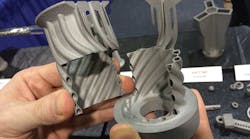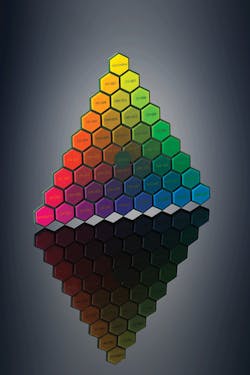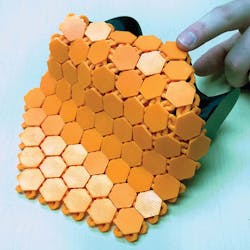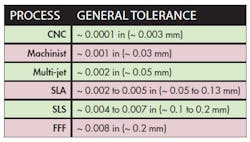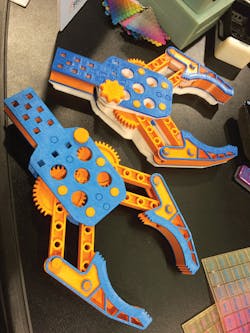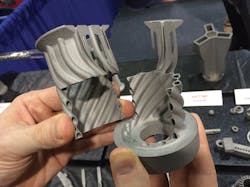This file type includes high resolution graphics and schematics when applicable.
3D printing is a fast-growing segment of the manufacturing market, with engineers and developers breaking through limitations as new innovations are developed. Designers in all disciplines and industries need to understand the machines, materials, and processes to get the most out of these new technologies.
Some popular 3D models offer users several ways of connecting them to 3D printers. These include wirelessly, through USB cables, or directly on the machine via onboard controls. However, having several connection options is a convenience—not a necessity for or limitation of the printer. The top concerns for printers tend to be cost, build space, tolerance, and the materials it can handle.
Cost is a limiting factor, so printer companies have reduced prices accordingly. For example, fused filament fabrication (FFF) and stereolithography (SLA) machines can cost as little as $1,300 to $3,000. Printers targeted for home use also have been reduced in price to just a few hundred dollars. For example, the Da Vinci Jr.—an FFF machine from XYZ Printing—is set to release in May of this year for $349. For some printers, including select laser sintering (SLS) models, sticker prices range from $12,500 to $33,000; those are for the more cost-effective models. SLS machines may drop below $10,000, but if this happens it will be slowly as these are more complex machines. One reason for this drop in prices is that several additive manufacturing (AM) patents have expired, opening the floor for other companies to compete in the industry.
Watch “This 3D Printer Costs Only $349” courtesy of Engineering TV, below:
Economics is another limitation. When considering the cost-effectiveness of a 3D printer, engineers should bear in mind that having a larger build space can let a printer build multiple parts at once. Larger build spaces can often make a printer efficient and productive enough to justify its purchase. Normal spaces range from 5.5 to 12 in.3, though other sizes are available. For example, 3DP Unlimited’s X1000 boasts a 3.28 × 3.28 × 1.64 ft. (1 × 1 × 0.5 m) build space.
Watch “3D Printing Goes Big with the 3DP1000” courtesy of Engineering TV, below:
When 3D printing competes with other processes, the winner sometimes can be decided by determining which can make parts faster. 3D printing build times also affect tolerance. In one test, 3DP Unlimited printed a chair using FFF in 200 hr. (8 days) by increasing the thickness of each layer, commonly referred to as resolution. In this test, the print time was cut to 35 hr. For FFF, changing resolution entails altering the nozzle size.
The 200-hr print was done with a 0.003 in. (0.07 mm) nozzle. Switching to a 0.047 in. (1.2 mm) nozzle, print time is cut by 83%. Print time can also be shortened by increasing the print head’s speed. Companies are starting to think about adding several heads to decrease production times. Stacker, for example, has built a printer with four heads that operate simultaneously.
Speed limitations can be reduced by resolution, increased speeds, or multiple heads. However, managers at Senvol, a company that focuses on quantifying the business implications of adopting additive manufacturing, say there is a bigger picture. Understanding the whole process is key to determining whether (and how) additive manufacturing will add value to a company.
Zach Simkin, Senvol’s president, advocates a wider approach than just finding small, complex parts produced in small volume. Companies can save by analyzing the entire supply chain. A part might be more expensive or take longer to 3D print. However, 3D printing could alleviate bottlenecks, reduce downtime, or save money over the entire manufacturing line.
Educating companies about additive manufacturing is another key. Stratasys Applications Engineer Mark Bashor explains: “Taking build space, tolerance, and other quantitative values into consideration is not the whole picture. General operator and facility friendliness are also important. Does the printer need ventilation? Is the software user friendly? Does the printer come with a maintenance package?”
A 3D printer has several tolerances, which can confuse some users. Resolution tolerance, for example, is the ability to maintain the same layer thickness for each cross-section of the part. Dimensional tolerance refers to the ability to meet the part’s geometric demands. Then there are accuracy and precision tolerances. On top of this, both accuracy and precision have a repeatability tolerance. Many companies post resolution and available nozzle or laser sizes with the printers, but it can be difficult to get GD&T information on parts it can make.
GD&T’s difficultly stems from all the possible dimensions and geometries. A round nozzle might make an accurate line, but may not be able to hold the same tolerances while printing a tight outside corner. As companies look to 3D printing to make finished parts, easy access to GD&T data will be necessary.
Limitations in capital are being aided by crowdsourcing. For example, Peachy is about to start delivering photolithograph 3D printers to users this July. Users can assemble them themselves for around $100 or buy them assembled for about $1,000. In Peachy’s case, it lowered the price by simplifying the machine.
Most 3D printers have a Z axis controlled by accurate but costly parts. Just an anti-backlash spindle and nut can exceed $40. Peachy eliminated Z-axis controls by floating resin on salt water. The water level rises between layers, letting the next cross-section be printed. Peachy also saves money by using a photo resin that gets cured by a laser with less power than other, more expensive 3D printers.
Watch “Peachy Printer Floats Resin on Salt Water” curated by Engineering TV, below:
Other companies have used engineering power to reduce limitations. Hermle, for instance, used a team of 20 engineers to introduce a process called metal powder application, a seven-year process. It is similar to the powder jet SLS, but doesn’t use a laser. Instead, it heats the powder in a jet of super-heated steam.
Heated metal powder passes through a nozzle and hits the substrate at three times the speed of sound. The impact creates a force of 1,450 psi (10 GPa) and temperatures up to 1,832º F (1,000o C). The heat and pressure forges the metal powder into a sold part. The entire process takes place on a five-axis CNC milling machine.
This file type includes high resolution graphics and schematics when applicable.
The Materials
This file type includes high resolution graphics and schematics when applicable.
New materials are constantly being developed. “Polymers used in 3D printing are non-crystalline materials that have a larger gap between the melt and glass transition temperatures,” says Bashor. “For a polymer like nylon, these properties are relatively close. To use nylon in 3D printing, it is altered to increase this gap.”
For SLA, materials must be liquid photopolymers or photo-resins. The laser travels through the material, so optical quality is also important. Companies using SLS want materials that are easy to purchase. Access to powders has been limited, but is becoming more available as popularity increases, according to JK Lasers Product Manager Simon Caiger. New carbon-fiber composite ABS filament can also be difficult to find and costly. Limitations on accessibility and cost led engineers at Strati and Local Motors to use carbon fiber composite ABS pellets, rather than filament, when deciding what to use when printing their new cars.
The popularity of 3D printing is also reducing limitations. Companies are generating many new FFF materials to gain market share in this fast-growing industry. In fact, this spawned a joint venture between Graphene Laboratories and Lomiko Metals to form Graphene 3D lab. This new company is turning out graphene oxide composite, a 3D printing material that offers thermal and electrical conductivity. It has a volume resistivity of 1 ohm-cm, which let Graphene 3D lab print a battery with the same voltage as an AA battery.
Materials with electrical properties have been a focus for other companies as well. Voxel8 created a silver ink to be used in a 3D printer. The material has about 2 million S/m. For comparison, conductive pastes are about 400 S/m, and conductive filaments are in the100 S/m range. Voxel8’s ink prints at room temperatures and setups up in about 15 minutes. Daniel Oliver, one of Voxel8’s co-founders, says the printer does not have to stop to let the ink dry. The ink can be printed over without stopping and its properties are not affected.
Watch “3D Print Durable Parts with FDM Technology from Stratasys” courtesy of Engineering TV, below:
There have also been a host of new materials involving clay, wood, and bamboo. These new materials can be hard and durable enough to print a car, or soft and spongy enough to print a comfortable shoe. Industry experts say there is a trend toward 3D printers capable of printing with several materials at once. Stratasys’ multi-jet process, known as Polyjet, can printing three materials simultaneously without stopping.
Polyjet lets materials be blended for a larger palate of colors and wider range in properties. This reduces processing time for 3D printed parts, as the operation does not need to stop to change materials. Parts no longer need to be printed separately and assembled. This can also reduce or eliminate post-processing steps such as painting.
Developing parts so living hinges and springs can be printed into parts reduces the number of parts in an assembly, saving more time and money. Companies are also starting to print full assemblies, made possible by the way the layout of the part is designed. If the assembly needs to be dynamic a dissolvable polymer can separate the parts during the print and be removed in a finishing process.
With all of this innovation, are new material properties pushing printer developments, or are printer constraints pushing development of materials with new properties? Both, says Eric Utley, applications engineer for Proto Labs.
“It depends on the technology in question,” he says. “For a process like stereolithography, the material must be a photopolymer that solidifies with exposure to a specific wavelength of light…This means that you will never be able to print a ‘production’ plastic like ABS or polycarbonate via stereolithography. In this sense, the technology is built around the material.
“Direct Metal Laser Sintering allows 3D printing in metal,” Utley continues. “However, there are several in-demand metal materials, such as aluminum and copper, that are very technically challenging to make in this process. There needs to be additional innovation in the technology to adapt to the technical hurdles posed by these materials so that new applications can be explored. DMLS needs to adapt as a technology to accommodate these high demand materials.”
Environmental concerns are another set of limitation companies should be concerned about. 3D printing is a minimum waste process compared to most machining operations. The amount of energy that goes into an ingot or billet to be milled or lathed away generates a lot of waste. Other than some finishing processes and support material, most of the energy that goes into making filament or powder for a 3D printed part ends up in the finished part.
Watch “3D Printers Blend Materials and Colors with PolyJet Technology” courtesy of Engineering TV, below:
Companies can cut the environmental harm of 3D printing by recycling old parts. To simplify recycling materials, Extrusion Bot is working on producing a parts crusher and a filament extruder. The machines work together to grind up parts that are no longer needed or broken, then extrude new filament to be used again.
3D printing was a complicated process that has been simplified into a plug-and-play machine. Now it is maturing from a machine that made knick-knacks to one that can build innovative products. But will 3D printers ever be common household appliances? Not according to Utley.
“3D printing moving into the ‘average’ home is quite a ways away,” he says. “I do not foresee it being as popular as the PC or microwave, but maybe eventually it will become as popular as a home workshop drill press or table saw.”
It’s more likely 3D printing will find its niche in industrial manufacturing. “There has a lot of interesting developments, such as GE’s leap engine which contains 3D-printed parts and others are utilizing 3D printers to increase their low volume manufacturing of end use parts.” says Stratasys Applications Engineer Michael Block. “Some companies are already testing the use of 3D printing to mass produce finished small parts. Others are working with the 3D printers to increase their productivity so they can start mass production with 3D printing.”
There was a general consensus among those interviewed that people may use 3D printers for arts and crafts, but will still go to local stores to purchase hardware, plates, and other items. This doesn’t mean the home market will be small. But the commercial and industrial 3D printing industry will continue to grow and offer more services.
7 Reasons to Use Additive Manufacturing
Based on all of the analyses that it has conducted, Senvol has determined that there are seven supply chain scenarios that tend to lend themselves well to additive manufacturing. They use these scenarios in an algorithm to show how additive manufacturing could increase value to companies in different ways.
Expensive to manufacture: If complex geometry or high fixed costs leads to high prices, or production volumes are low, AM might be more cost-effective approaches.
Long lead times: If downtime costs are extremely high because of lead times on parts AM could offer a solution for this.
High inventory costs: AM allows for on-demand production, reducing the need for inventory.
Sole-sourced from suppliers: By qualifying parts for AM, companies will no longer be as reliant on suppliers.
Watch a Senvol Presentation at 2015 RAPID about selecting the most cost-effective location for additive manufacturing, courtesy of Engineering TV, below:
Remote locations: when remote locations restrict delivery of parts, on-site AM can eliminate delivery times.
High import/export costs: On-site AM production also eliminates high import/export cost.
Improved functionality: AM can redesign parts so that performance is improved, resulting in larger profit margins or market share.
Senvol also offers a free online database for engineers to find printers and materials that may fit their AM needs.
This file type includes high resolution graphics and schematics when applicable.
